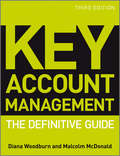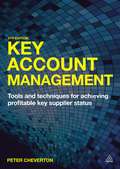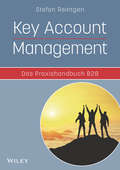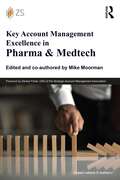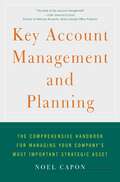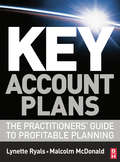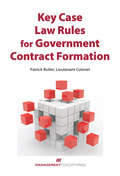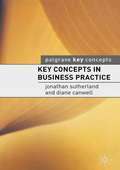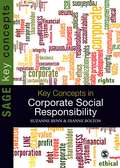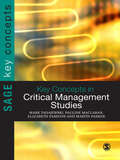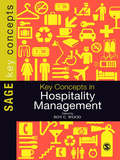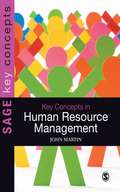- Table View
- List View
Kevin Sharer at Amgen: Sustaining the High-Growth Company (A)
by Andrew N. Mclean William W. GeorgeIn 2005, Kevin Sharer reflects on the challenges of sustaining the growth and success that have brought Amgen to the position of third-largest U.S. pharmaceuticals company by market capitalization and the challenge of maintaining the higher P/E ratio it traditionally held. Profiles the leadership and development of Sharer, tracing his career from the U.S. Navy through McKinsey and Co., GE, and MCI to his entrance at Amgen as president and COO. Provides information on the history and business of Amgen and its science-based discovery model. Provides information about the protagonist's career, management style, learning style, aspirations, and motivations. Raises questions about leadership in sustaining discovery-driven growth and leadership succession.
Kevin Simpson
by Linda A. Hill Melinda B. ConradFollows Kevin Simpson, a second-year Harvard Business School 1990 student, through his job search to his final decision between two very attractive but different job offers: a job as an international marketing manager at Eli Lilly and Co., a leading multinational health product corporation; and a position as the assistant to the president of Haemonetics, an entrepreneurial company in the biomedical equipment field. Addresses the factors Simpson should consider when making job choices as well as the issues he faces as an African-American professional.
Key Account Controlling in der pharmazeutischen Industrie
by Sabine RinauerDas deutsche Gesundheitssystem ist ein komplexes Regulierungsgefüge. Damit die Marktteilnehmer die Konsequenzen ihres Handelns einschätzen können, werden die Kenntnis von Interdependenzen und die frühzeitige Information über Veränderungen der Rahmenbedingungen immer wichtiger. Durch die Konsolidierung der Nachfragestrukturen gewinnt die Fokussierung auf die zentralen Schlüsselkunden für die Arzneimittelhersteller an strategischer Bedeutung. Die damit verbundene Veränderung im absatzwirtschaftlichen Geschäftsmodell verändert den Informations- und Koordinationsbedarf maßgeblich und stellt somit neue Anforderungen an das Controlling. Neue praxistaugliche Instrumente zur Entscheidungsunterstützung und Verhaltenssteuerung im pharmazeutischen Key Account Management werden benötigt.
Key Account Management
by Malcolm Mcdonald Diana Woodburn"This book is crammed with distilled, practical wisdom for key account managers and their directors. Organizations claiming to practise key account management should equip everyone involved with a copy, so they really understand what they are supposed to be doing. Anything less is just old-fashioned selling."Developing successful business-to-business relationships with more customers in highly competitive markets requires processes and skills that go beyond traditional selling activity. The very best state-of-the-art strategies are set out clearly in this book by intentionally known authors who have worked at the highest levels with more key and strategic account managers worldwide than probably any other leading advisors. Based on the hugely influential KEY CUSTOMERS it looks at:Why has account management become so critical to commercial success?What are the key challenges and how do successful companies respond?What part does key account management play in strategic planning?How do companies build profitable relationships with their customers?How does key account management actually work?What does a successful key account manager look like and what skills does he/she need?How should key account managers be evaluated and rewarded?How do companies achieve key account management? By addressing these key questions Woodburn and McDonald provide tools and processes for success honed by tough consultancy projects with the boards of some of the world's leading companies. The book stresses the elements that really matter - from developing a customer categorization system that really works and analyzing the needs of key accounts; to understanding the new skills required by key account managers and ensuring that key account plans are implemented. The 'real world' approach is backed by tested principles and the latest research from the renowned Cranfield School of Management.Key Account Management comes from authors who have taught leading companies how to approach their most powerful and demanding customers and still make money. It is essential reading for all senior management with strategic responsibility, for key or strategic account directors, and for marketing and sales executives. The clear and authoritative approach also makes it an outstanding text for the serious MBA and executive student as well as business-to-business company directors and key account managers.
Key Account Management
by Peter ChevertonAn organization's key accounts are its lifeblood. Key account management focuses on the long-term investment of resources in customers that can offer an exceptional return on resources. But which are the key accounts? Are they the ones growing the fastest? The ones that are most financially secure? Or are they the ones that shout the loudest? Key Account Management puts forward a straightforward and effective planning methodology. This fully updated sixth edition of Key Account Management takes a long-term, team-selling strategic view of the whole process, from defining the customer, to managing the relationship and achieving key supplier status. With coverage of latest best practice including IT's role in account management, plus new case studies, online supporting resources and a new section comparing how different industries/markets approach key account management, it stands alone as the premier book on managing key customers.
Key Account Management - Das Praxishandbuch B2B
by Stefan ReintgenIhre B2B-Topkunden bewegen die Märkte, treiben die Leistungsgestaltung voran, fordern dafür ihre Lieferanten heraus, werden stets professioneller und tougher im Einkauf, nutzen sehr effektiv die weltweit verfügbare Anbieterbasis, sind hochgradig wechselbereit und für Ihr Unternehmen unverzichtbar. Falls diese Beschreibung Ihre Realität abbildet, brauchen Sie für diese Kunden ein top-funktionierendes Key Account Management. Viele Unternehmen haben es eingeführt, einige sind zu strategischen Partnern ihrer Schlüsselkunden geworden. Häufig wird diese Qualität jedoch nicht erreicht. Die Gründe dafür sind vielfältig. Die gute Nachricht: Sie sind überwindbar. Dieses Buch vermittelt geeignete Ansätze, aktuelle Werkzeuge und State-of-the-Art-Praktiken, die im professionellen KAM angewendet werden. Mit diesem Praxishandbuch können Sie Ihre Fragestellungen anhand des integrierten KAM-Performance-Konzeptes fokussiert oder schrittweise angehen. Dafür stellt es Ihnen Best Practices zur Verfügung, einige auch als Download. Sie erhalten zahlreiche Tipps, viele davon aus Projekten mit Kunden. Ihre Key Accounts sind Ihre werthaltigsten Kunden. Der Wert liegt in den kurzfristigen Erfolgsgrößen und in der langfristigen Unternehmensentwicklung. Dafür lohnt es sich, gutes und richtiges KAM zu praktizieren.
Key Account Management Excellence in Pharma & Medtech
by Mike MoormanKey Account Management Excellence in Pharma & Medtech is designed to help life sciences practitioners develop and execute innovative and effective key account management (KAM) strategies and capabilities. Pharmaceutical and medtech companies are increasingly pursuing KAM in response to the rapid rise of large, sophisticated and complex healthcare provider and payer systems and groups. Those that invest the time to get KAM right will protect their business and grow with these rising customers. This book is groundbreaking in both its scope and its tailoring of leading KAM practices specifically for life sciences. The central theme is that "key account management is an organization-wide business strategy, not just a role or a sales-specific initiative." KAM is a strategy focused on providing unique offerings and value through an orchestrated, cross-functional, go-to-market model designed specifically to address the needs and engagement preferences of a unique segment of customers. The insights and practices shared in this book are designed to be a valuable reference at every stage of the KAM journey. The book has been designed to facilitate a common language and deep understanding of KAM issues and leading practices organization-wide—particularly for life sciences leaders, account managers and cross-functional team members responsible for building, transforming and supporting their organization’s KAM strategies and capabilities.
Key Account Management and Planning: The Comprehensive Handbook for Managing Your Company's Most Important Strategic Asset
by Noel CaponThe vastly increased level of competitive intensity faced by corporations and the increased costs of selling have radically changed the nature of the traditional selling process. Key or "strategic" accounts have now become a company's most important asset, in some cases supplying in excess of 80 percent of a firm's revenues. Here, in one powerful volume, key account management expert Noel Capon provides the most comprehensive treatment of key account management and planning yet published. For the first time, Capon introduces his breakthrough four-part "congruence model" of key account management -- a new, thoroughly researched approach to optimally managing your key account portfolio. First, the author shows how to select and conceptualize the key account portfolio; second, how to organize and manage key accounts; third, how to recruit, select, train, retain, and reward key account managers; and fourth, how to formulate and execute strategy and issues of coordination and control. This congruence model serves as a backdrop as Capon takes the reader step-by-step through the vital functions of key account management including identifying key account criteria, considering the threats and opportunities for the key account, and understanding the roles and responsibilities of critical players. Capon backs up his points with extensive research, real-life stories of successes and failures at a variety of companies, and clarifying figures. Special chapters are devoted to partnering with key accounts and in-depth information on global key account management, an increasingly important weapon for staying ahead of the competition. Timely, important, and essential, Key Account Management and Planning is the only reference handbook those with key account responsibilities will ever need.
Key Account Management erfolgreich planen und umsetzen
by Hartmut H. BieselErwirtschaften auch Sie 80 Prozent Ihres Umsatzes mit 20 Prozent Ihrer Kunden? Dann kommen Sie am Thema Key Account Management nicht mehr vorbei. Für die Betreuung von Top-Kunden gibt es jedoch kein Patentrezept. Nur individuelle, auf das jeweilige Unternehmen zugeschnittene Konzepte bringen langfristig mehr Erfolg. Hartmut H. Biesel zeigt anschaulich, wie dazu Unternehmenskultur, Vertriebsstrategie und Umsetzungstools miteinander verzahnt werden müssen. Sie erfahren, wie Sie Key Account Management in Ihrer Organisation einführen und Gewinn bringend umsetzen, mit Hilfe welcher Kriterien Sie die wertigen Kunden bestimmen, wie Sie einen entscheidenden Mehrwert für Ihre Schlüsselkunden schaffen und wie Ihr Key Account Management die Aufgaben des Alltagsgeschäfts erfolgreich bewältigt. Ein systematischer und zugleich anregender Leitfaden mit wichtigen Analysetools zur Markt- und Kundenbewertung, Checklisten, Praxisbeispielen und Umsetzungshilfen. Unverzichtbar für alle, die Key Account Management einführen oder optimieren wollen! Neu: In die 3. Auflage sind die Empfehlungen der European Foundation for Key Account Management (EFKAM), einem Gremium aus Wissenschaftlern, Beratungsspezialisten und Praktikern aus der Wirtschaft, eingeflossen.
Key Account Management, kompakt: Effiziente Entwicklung von Großkunden, Kundenzufriedenheit und Kundenwert aktiv managen
by Roberto CaponeDas Buch zeigt, wie Kundenzufriedenheit zu Kundenbindung und zu einer Optimierung des Kundenwertes führt. Bestandskunden, insbesondere Groß- und Schlüsselkunden zu halten, zu begeistern und die Bedürfnisse im Buying Center zu befriedigen, ist eine wichtige Aufgabe für MitarbeiterInnen im Vertrieb und Key Account Management. Zufriedenheitsmessung ist ein zentrales Werkzeug für die nachhaltige Kundenentwicklung.
Key Account Plans
by Malcolm McDonald Lynette RyalsTo manage key accounts profitably you need strategic planning that works. This book is the definitive guide to achieving this based on the unmatched practical and research experience of Ryals and McDonald. Key Account Management is proven to deliver substantial benefits to the bottom line. Best practice companies know that real results from managing powerful customers are not achieved through short-term cost cutting. Instead, as the best companies understand, it depends on fostering carefully developed and profitably managed relationships with an equally carefully selected group of key accounts. This is a genuinely strategic activity that goes well beyond sales management and the simplistic use of budgets to generate targets. It is about the behaviours and practices that make predictable, profitable and sustainable Key Account Management possible. To achieve this the book is constructed to deliver-* Clear descriptions of the various techniques and the reason for their importance* A hugely powerful step by step approach to using the key techniques to build strategic skills * Templates for building real plans* Cases, examples and vignettes to show best real world practice Based on wide application in the business world, and the world class research at Cranfield Management School this book will be an essential introduction to the principles and reality of Strategic Key Account Planning. For senior managers, key account managers at all levels as well as those on executive and MBA courses it will be an essential guide and text.
Key Actors in Public Policy-making for Quality of Life: Facilitators and Obstacles (Human Well-Being Research and Policy Making)
by Graciela TononThis book analyzes how quality of life research results can be transferred to policy making, and considers the role of actors in this process---researchers, policy makers, and citizens---as well as their interrelationships. This book points to the need to include actors other than the state in public policy-making related to quality of life and well-being issues, in defining problems and formulating alternatives. It identifies obstacles and facilitators in the process and offers a review of different types of aid that affect well-being and quality of life. Finally, it shows possible pathways for various stakeholders in policy-making to interact with one another in the building of good societies.
Key Aspects of German Employment and Labour Law
by Jens Kirchner Pascal R. Kremp Michael MagotschThis publication gives an overview of all key aspects of German labour and employment law as well as adjoining fields. Legal professionals with expert knowledge and many years of experience explain the legal basis of these aspects of German law, point out typical practical problems and suggest solutions to those problems. In addition, examples are given on how to best manage legal pitfalls to minimize risks. This book translates employment and labour law for foreign in-house counsels and human resources managers at international companies and provides a clear understanding of the complex legal regulations in Germany. All three editors of the book, Dr. Jens Kirchner, Pascal R. Kremp and Michael Magotsch, are key legal professionals working at the Frankfurt office of DLA Piper, one of the largest legal services providers in the world (www.dlapiper.com), with national and multinational clients. Their experience includes the management of cross-border restructurings, outsourcing and transfer of undertaking measures, as well as the management of national and multi-jurisdictional merger and acquisitions projects, including post-merger integration processes.
Key Aspects of German Employment and Labour Law
by Jens Kirchner Pascal R. Kremp Michael MagotschThis publication gives an overview of all key aspects of German labour and employment law as well as adjoining fields. Legal professionals with expert knowledge and many years of experience explain the legal basis of these aspects of German law, point out typical practical problems and suggest solutions to those problems. In addition, examples are given on how to best manage legal pitfalls to minimize risks. This book translates employment and labour law for foreign in-house counsels and human resources managers at international companies and provides a clear understanding of the complex legal regulations in Germany. All three editors of the book, Dr. Jens Kirchner, Pascal R. Kremp and Michael Magotsch, are key legal professionals working at the Frankfurt office of DLA Piper, one of the largest legal services providers in the world (www. dlapiper. com), with national and multinational clients. Their experience includes the management of cross-border restructurings, outsourcing and transfer of undertaking measures, as well as the management of national and multi-jurisdictional merger and acquisitions projects, including post-merger integration processes.
Key Case Law Rules for Government Contract Formation
by Patrick Butler Lt. ColGo Beyond the FAR!The guidance contained in the almost 2000 pages of the Federal Acquisition Regulation and the various agency supplements are just a part of the resources government acquisition professionals need to do their jobs effectively. Accessing and understanding case law is equally important to a thorough understanding of government contracting. Legal decisions explain the Government Accountability Office's and the courts' views on how procurement statutes and regulations apply in a wide range of situations. Case law also gives potential bid protesters and agencies a way to gauge the likely outcome of a protest.Until now, it has been difficult to find and understand the legal decisions that could be relevant to a particular situation. Key Case Law Rules for Government Contract Formation changes that by organizing and explaining the most important protest grounds in a readily accessible and comprehensible way. With an emphasis on more recent cases, the book is organized around the key protest grounds, such as pricing issues, allegations that the government wrongfully prevented competition, or improper sealed-bidding procedures.Bridging the gap of understanding between the legal and the contracting communities, this book is a much-needed addition to the essential resources for acquisition professionals.
Key Challenges and Policy Reforms in the MENA Region: An Economic Perspective (Perspectives on Development in the Middle East and North Africa (MENA) Region)
by Mohamed Sami Ben AliThis volume addresses economic challenges and policy reforms in the Middle East and North Africa (MENA) region. Despite important resources and strategic advantages, the region suffers from a number of economic, social, and political problems that impedes normal economic take-off. The volume contains theoretical and empirical studies covering individual countries and panel studies addressing these economic challenges. Chapters address issues such as economic growth; poverty and inequality; subsidies and public finances policies; external trade and financial liberalization; remittances, corruption, transparency, and institutions; renewable energy, digitalization, terrorism, regional integration, capital flight, money laundering, financial development and brain drain. Providing a comprehensive understanding of the most important and urgent economic challenges in the region, this volume will be a useful reference for researchers and policymakers interested in the MENA region.
Key Concepts and Issues in Nursing Ethics
by P. Anne Scott Shane M. ScottThis second edition offers updates, new topics, and new short case studies, based on real stories from the health care arena, ensuring that each chapter of this book is rooted in descriptions of nursing practise that are grounded, salient narratives of nursing care. The reader is assisted to explore the ethical dimension of nursing practice: what it is and how it can be portrayed, discussed, and analysed within a variety of practice and theoretical contexts. One of the unique contributions of this book is to consider nursing not only in the context of the individual nurse – patient relationship but also as a social good that is of necessity limited, due to the ultimate limits on the nursing and health care resource. This book will help the reader consider what good nursing looks like, both within the context of limitations on resources, during crises situations, and under conditions of scarcity. Indeed, any discussion of ethical issues in nursing should be well grounded in aconceptualisation of nursing that nursing students and practising nursing can recognise, accept and engage with. Nursing, like medicine, social work and teaching has a clear moral aim – to do good. In the case of nursing to do good for the patient. However it is vital that in the pressurised, constrained, post-COVID-19 pandemic health service of the 21st century, we help nurses explore what this might mean for nursing practice and what can reasonably be expected of the individual nurse, and the nursing profession, in terms of good nursing care.
Key Concepts in Accounting and Finance
by Diane Canwell Jonathan SutherlandKey Concepts in Accounting and Finance is one of a range of comprehensive glossaries with entries arranged alphabetically for easy reference. All major concepts, terms, theories and theorists are incorporated and cross-referenced. Additional reading and Internet research opportunities are identified. More complex terminology is made clearer with numerous diagrams and illustrations. With almost 600 key terms defined, the book represents a comprehensive must-have reference for anyone studying a business-related course or those simply wishing to understand what accounting and finance is all about. It will be especially useful as a revision aid.
Key Concepts in Business Practice
by Diane Canwell Jonathan SutherlandKey Concepts in Business Practice is one of a range of comprehensive glossaries with entries arranged alphabetically for easy reference. All major concepts, terms, theories and theorists are incorporated and cross-referenced. Additional reading and Internet research opportunities are identified. More complex terminology is made clearer with numerous diagrams and illustrations. With over 500 key terms defined, the book represents a comprehensive must-have reference for anyone studying a business-related course or those simply wishing to understand what business practice is all about. It will be especially useful as a revision aid.
Key Concepts in Corporate Social Responsibility (SAGE Key Concepts series)
by Suzanne Benn Dianne BoltonIntroducing the key concepts in corporate social responsibility, the authors bring together the essential issues relevant to the responsible management of businesses, not-for-profit organizations and government. With detailed coverage and cross-referencing for each concept and over 50 concepts introduced, this guide to both the theory and implementation of CSR and sustainability, provides an indispensable reference for any student of the subject. Key concepts include: accountability; business ethics; corporate citizenship; corporate environmental reporting; definitions of CSR; ethical consumerism; human rights; NGOs; risk management; stakeholder theory and sustainable development.
Key Concepts in Critical Management Studies (SAGE Key Concepts series)
by Martin Parker Mark Tadajewski Pauline Maclaran Dr Elizabeth ParsonsIdeal as an introduction and as a quick reference, Key Concepts in Critical Management Studies explores the essential concepts used within the field today. Specially edited and written by a range of international experts, key ideas are succinctly explained and illustrated beyond a simple definition. Further reading suggestions and cross-referencing provide the reader with means to develop their knowledge further.<P><P> With over 50 entries, from Actor Network Theory to Utopianism, readers have instant access and explanation of the most influential concepts in CMS literature. Clear and engaging, this will provide strong support for all courses involving critical management and is a perfect resource for anyone with an interest in this field.
Key Concepts in Event Management (SAGE Key Concepts series)
by Bernadette QuinnIn recent years we have seen an enormous growth of festivals and event activity and the literature within the field is consequently huge. In order to make sense of this rapid and dynamic development, students are dependent on a book that can lead them through the myriad of theoretical frameworks offered.<P> <P> This book naturally situates itself in the middle of this need, offering a comprehensive and illuminating account of the festival and event field. Written with academic rigour yet accessible at the same time, Quinn proves herself to be an outstanding communicator and stimulator of knowledge. <P> International in content and timely in its up to date coverage of key topics, this will be an invaluable reference source for students from Event Management, Tourism and Leisure studies. It will also be of great use for students from Business Studies, Marketing, Cultural Studies and Geography.
Key Concepts in Hospitality Management (SAGE Key Concepts series)
by Roy C. WoodThis edited book covers the major concepts you are likely to encounter throughout their study within the hospitality field, giving a comprehensive and up-to-date overview as well as providing engaging everyday examples from around the world. <P><P> A leading figure in the field, Wood has successfully gathered international contributors with direct experience of hospitality management and the hospitality industry as a whole, ensuring both the academic, geographical and practical integrity of the book. <P> Key Concepts in Hospitality Management is written for undergraduate students and those studying short postgraduate or executive education courses in hospitality. It would also be of use to the general academic reader seeking information on the hospitality industry and hospitality management.
Key Concepts in Human Resource Management (SAGE Key Concepts series)
by John MartinKey Concepts in Human Resource Management is an essential guide to the theories and issues that define the field - from the critical debates to the more practical considerations that every student should be aware of.<P> 52 short and snappy entries serve to orientate the student round the need-to-know essentials.<P> - Entries include Employment Tribunals, Benefits, Corporate Social Responsibility, Discipline and Grievance, Control, Employee relations, Incentive schemes, Motivation, Organizational culture, Strategic HRM, Victimisation.<P> - A range of relevant HR applications will be given for each term.<P> - A selection of recommended readings are suggested for each entry.<P>
Key Concepts in International Business
by Diane Canwell Jonathan SutherlandKey Concepts in International Business is one of a range of comprehensive glossaries with entries arranged alphabetically for easy reference. All major concepts, terms, theories and theorists are incorporated and cross-referenced. Additional reading and Internet research opportunities are identified. More complex terminology is made clearer with numerous diagrams and illustrations. With over 500 key terms defined, the book represents a comprehensive must-have reference for anyone studying a business-related course or those simply wishing to understand what international business is all about. It will be especially useful as a revision aid.


